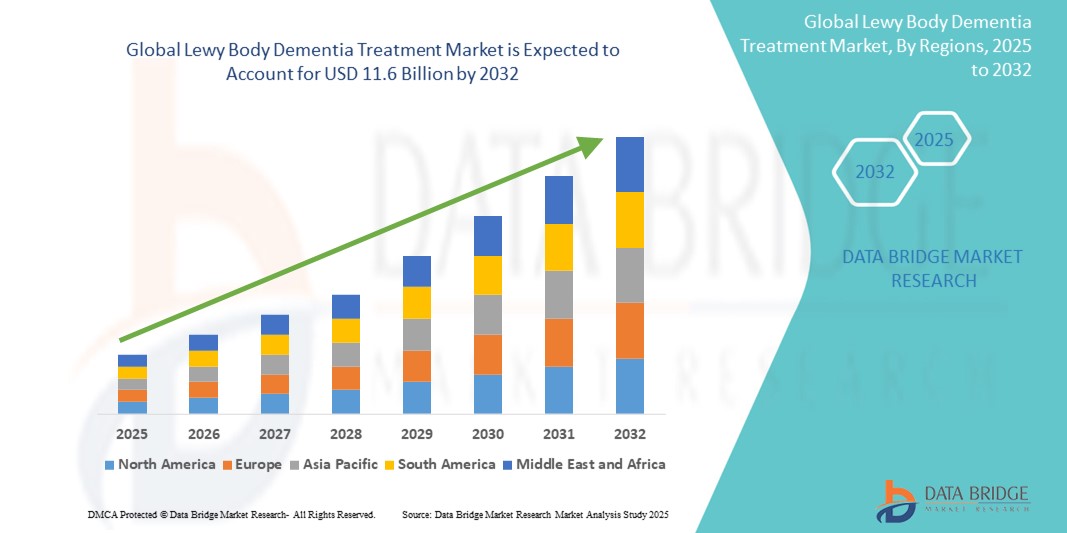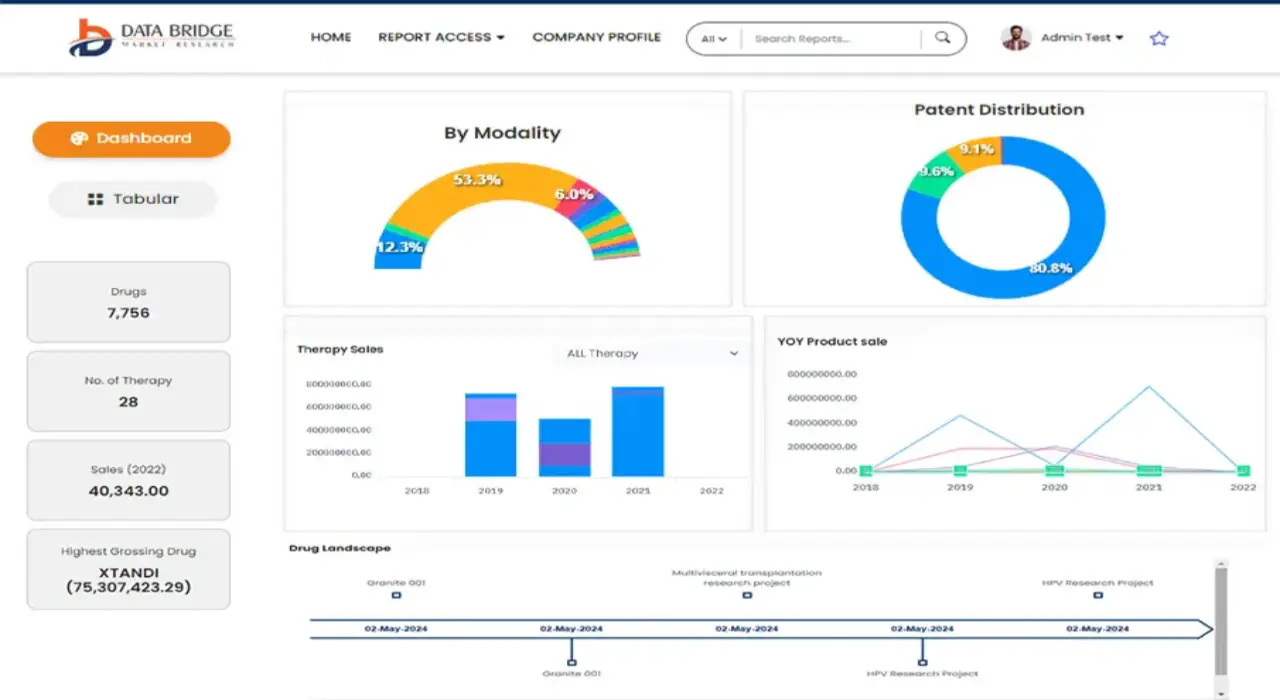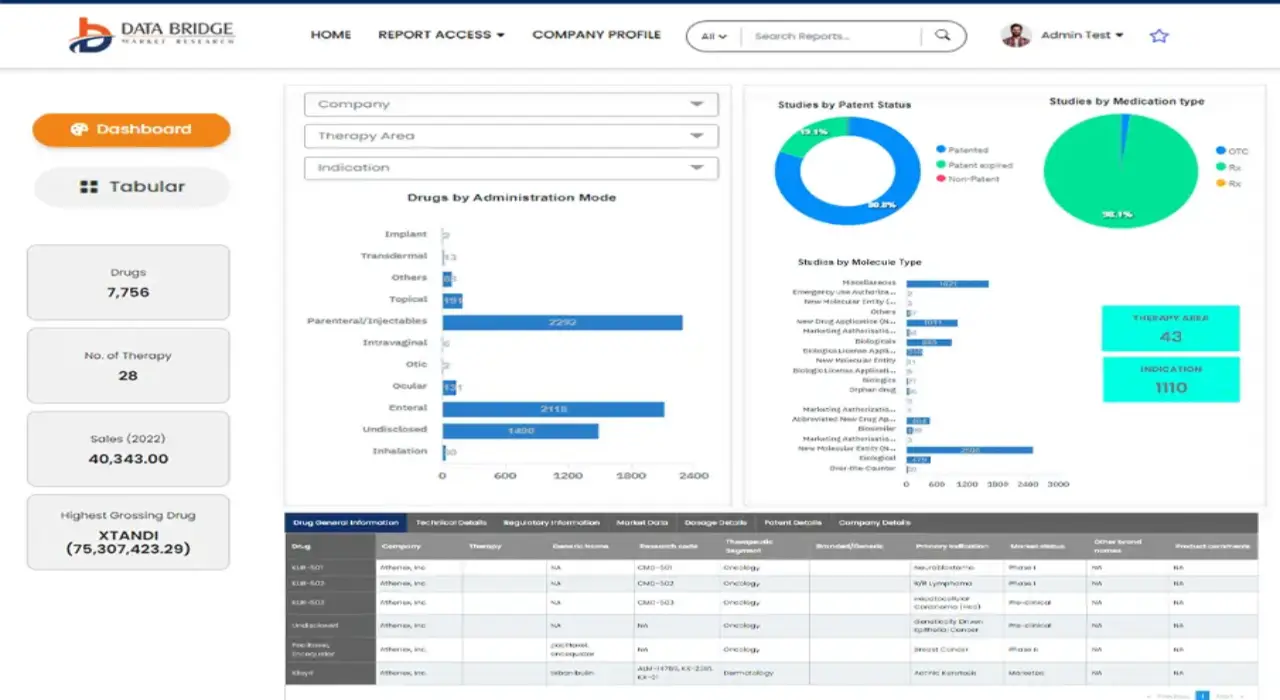Global Lewy Body Dementia Treatment Market
Market Size in USD Billion
CAGR :
% 
 USD
6.12 Billion
USD
11.60 Billion
2024
2032
USD
6.12 Billion
USD
11.60 Billion
2024
2032
| 2025 –2032 | |
| USD 6.12 Billion | |
| USD 11.60 Billion | |
|
|
|
|
Global Lewy Body Dementia Treatment Market Segmentation, By Drug Type (Cholinesterase Inhibitors, Antipsychotic Drugs, Antidepressants, Benzodiazepine, and Modafinil), Application Type (Parkinson’s Disease and Alzheimer’s Disease), Mode of Purchase (Prescription and Over the Counter), Distribution Channel (Hospital Pharmacies, Retail Pharmacies, and Online Pharmacies and Others) - Industry Trends and Forecast to 2032
Lewy Body Dementia Treatment Market Size
- The global Lewy body dementia treatment market size was valued at USD 6.12 billion in 2024 and is expected to reach USD 11.60 billion by 2032, at a CAGR of 8.30% during the forecast period
- The market growth is largely fueled by the increasing prevalence of neurodegenerative disorders and the rising awareness surrounding Lewy body dementia (LBD), prompting earlier diagnosis and medical intervention. Advancements in imaging techniques, genetic research, and clinical understanding of LBD are further supporting the identification and management of this complex condition
- Furthermore, growing consumer demand for effective, patient-centric, and multimodal treatment options—including pharmacological therapies and supportive care—is establishing integrated LBD treatment as the new standard in neurodegenerative disease care. These converging factors are accelerating the adoption of Lewy body dementia treatment solutions, thereby significantly boosting the industry's growth across both developed and emerging healthcare markets
Lewy Body Dementia Treatment Market Analysis
- Lewy Body Dementia (LBD) treatments, including medications and supportive therapies, are becoming increasingly vital components of neurodegenerative disease management strategies across both clinical and home care settings due to the progressive nature of the disease and its overlapping symptoms with Alzheimer’s and Parkinson’s
- The growing demand for LBD treatment is primarily fueled by the aging population, increased awareness of neurodegenerative disorders, and the development of more targeted therapies focusing on symptom management, especially cognitive fluctuations, hallucinations, and motor impairments
- North America dominated the Lewy body dementia treatment market with the largest revenue share of 41.3% in 2024, attributed to early adoption of advanced neurological diagnostics, strong healthcare infrastructure, increased funding for dementia research, and a high prevalence of LBD cases in the aging U.S. population
- Asia-Pacific is expected to be the fastest growing region in the Lewy body dementia treatment market, with a projected CAGR of 8.7% from 2025 to 2032, driven by rising geriatric populations in countries such as Japan and China, improved healthcare access, and increased public and governmental focus on dementia-related disorders
- Prescription segment dominated the Lewy body dementia treatment market with a market share of 89.4% in 2024, as the majority of drugs for LBD require strict medical oversight due to potential side effects. This includes medications that affect neurotransmitter levels and carry risks of worsening symptoms if not carefully managed. The necessity for specialist prescriptions underscores the continued reliance on physician-led diagnosis and treatment pathways in managing Lewy body dementia
Report Scope and Lewy Body Dementia Treatment Market Segmentation
|
Attributes |
Lewy Body Dementia Treatment Key Market Insights |
|
Segments Covered |
|
|
Countries Covered |
North America
Europe
Asia-Pacific
Middle East and Africa
South America
|
|
Key Market Players |
|
|
Market Opportunities |
|
|
Value Added Data Infosets |
In addition to the insights on market scenarios such as market value, growth rate, segmentation, geographical coverage, and major players, the market reports curated by the Data Bridge Market Research also include in-depth expert analysis, pricing analysis, brand share analysis, consumer survey, demography analysis, supply chain analysis, value chain analysis, raw material/consumables overview, vendor selection criteria, PESTLE Analysis, Porter Analysis, and regulatory framework. |
Lewy Body Dementia Treatment Market Trends
“Rising Focus on Targeted Therapies and Personalized Medicine”
- A significant and accelerating trend in the global Lewy body dementia treatment market is the increasing focus on targeted therapies and personalized treatment approaches. As scientific understanding of neurodegenerative diseases deepens, researchers and pharmaceutical companies are exploring ways to tailor treatments to individual patient profiles, thereby improving therapeutic outcomes and minimizing adverse effects
- For instance, companies are advancing clinical research into novel agents that target alpha-synuclein accumulation—a key pathological hallmark of Lewy Body Dementia. These disease-modifying therapies have the potential to slow progression, offering a paradigm shift from current symptomatic treatments
- In addition, genetic and biomarker studies are increasingly informing treatment decisions, enabling the development of more precise pharmacological interventions. This evolving approach is being supported by technological advances in diagnostic imaging and cerebrospinal fluid analysis, which help identify patients most likely to benefit from specific therapies
- Collaborations between academic institutions and pharmaceutical firms are also enhancing the drug discovery process, with several promising compounds currently in Phase II and III clinical trials. These developments highlight the market's momentum toward personalized care and represent a major growth driver
- The shift from generalized treatment to individualized care is reshaping patient expectations and clinician strategies, fostering demand for more advanced and customized therapeutic options. This is further supported by growing regulatory encouragement for precision medicine, particularly in the neurodegenerative disease space
- The demand for effective, personalized, and disease-modifying treatments is growing rapidly across global markets, as patients and healthcare providers increasingly seek better management solutions for Lewy Body Dementia
Lewy Body Dementia Treatment Market Dynamics
Driver
“Growing Need Due to Rising Neurodegenerative Disorders and Aging Population”
- The rising prevalence of neurodegenerative conditions such as Alzheimer’s and Parkinson’s disease, which are closely linked to Lewy Body Dementia (LBD), is significantly increasing the demand for effective treatment solutions
- For instance, in April 2024, Acadia Pharmaceuticals announced the expansion of its research pipeline focused on dementia-related psychosis, including clinical advancements in drug candidates targeting hallucinations and cognitive impairments—key symptoms in LBD. Such initiatives are expected to drive the Lewy Body Dementia Treatment industry growth during the forecast period
- As global populations age, the incidence of LBD is expected to rise, prompting healthcare systems and pharmaceutical companies to focus more on early diagnosis and targeted treatment options
- Furthermore, improved awareness among healthcare professionals and patients is enabling earlier detection and intervention, which can significantly enhance quality of life. This trend is supporting the growing adoption of cholinesterase inhibitors, antipsychotic drugs, and antidepressants in both hospital and homecare settings
- The rising demand for personalized medicine, combined with advancements in neuroimaging and biomarker research, is encouraging innovation in LBD treatment and fostering market expansion
Restraint/Challenge
“Lack of Disease-Specific Drugs and Diagnostic Complexity”
- A major challenge facing the Lewy body dementia treatment market is the limited availability of disease-specific therapies. Many treatments currently used are repurposed from Alzheimer's or Parkinson’s disease protocols and are not tailored specifically for LBD patients
- For instance, the overlap of symptoms between LBD, Alzheimer’s, and Parkinson’s often leads to delayed or incorrect diagnosis, complicating treatment planning and limiting patient outcomes
- In addition, there are significant concerns regarding the side effects of antipsychotic medications in LBD patients, as they are often more sensitive and prone to adverse reactions. This deters some clinicians from prescribing medications, limiting the use of standard therapies
- Another challenge lies in regulatory barriers and the high cost associated with drug development in neurodegenerative disorders, which can delay the introduction of novel therapies to the market
- Overcoming these hurdles will require increased R&D investments, improved diagnostic tools, and a collaborative approach between pharmaceutical companies and healthcare providers to ensure safe and effective management of LBD
Lewy Body Dementia Treatment Market Scope
The Lewy Body Dementia Treatment market is segmented on the basis of drug type, application type, mode of purchase, and distribution channel.
• By Drug Type
On the basis of drug type, the lewy body dementia treatment market is segmented into cholinesterase inhibitors, antipsychotic drugs, antidepressants, benzodiazepine, and modafinil. The cholinesterase inhibitors segment dominated the largest market revenue share of 38.6% in 2024, owing to their effectiveness in improving cognition and reducing behavioral symptoms. These drugs, including donepezil and rivastigmine, are commonly prescribed as first-line treatments in Lewy Body Dementia, especially in mild to moderate stages.
The antipsychotic drugs segment is anticipated to witness the fastest growth rate of 21.3% from 2025 to 2032, driven by increasing cases of visual hallucinations and aggression in LBD patients. However, careful administration is crucial due to higher sensitivity to side effects in this population.
• By Application Type
On the basis of application type, the lewy body dementia treatment market is segmented into Parkinson’s Disease and Alzheimer’s Disease. The Parkinson’s disease segment accounted for the highest market share of 52.1% in 2024, due to the close pathological association between Parkinson’s and Lewy Body Dementia.
The Alzheimer’s disease segment to witness the fastest CAGR from 2025 to 2032, driven by misdiagnosis overlap and the use of Alzheimer’s therapies in early stages of LBD.
• By Mode of Purchase
On the basis of mode of purchase, the lewy body dementia treatment market is segmented into prescription and over the counter. The prescription segment held the largest market revenue share of 89.4% in 2024, as the majority of drugs for LBD require strict medical oversight due to potential side effects.
The over the counter segment to witness the fastest CAGR from 2025 to 2032, owing to the use of supportive therapies such as supplements and mood enhancers.
• By Distribution Channel
On the basis of distribution channel, the market is segmented into hospital pharmacies, retail pharmacies, online pharmacies, and others. The hospital pharmacies segment led the market with a share of 44.7% in 2024, driven by the preference for in-hospital prescription fulfillment following diagnosis by specialists.
The online pharmacies segment is expected to register the highest CAGR of 22.6% during the forecast period, fueled by increasing digital penetration, convenience, and discreet access to cognitive and neurological medications.
Lewy Body Dementia Treatment Market Regional Analysis
- North America dominated the lewy body dementia treatment market with the largest revenue share of 41.3% in 2024, driven by rising elderly populations, greater awareness of neurodegenerative disorders, and the presence of key pharmaceutical players. Increased funding for research and early diagnosis initiatives further boosts market growth
- Consumers in the region highly value innovative treatment options, caregiver support services, and improved diagnostic tools for dementia-related illnesses
- The growth is supported by high healthcare expenditures, widespread health insurance coverage, and a growing focus on quality-of-life improvements for dementia patients
U.S. Lewy Body Dementia Treatment Market Insight
The U.S. Lewy body dementia treatment market captured the largest share of 75% in 2024 within the North American Lewy Body Dementia Treatment market, driven by increased clinical trials, FDA approvals for dementia-related therapies, and strong public-private partnerships. The high diagnosis rates and growing geriatric population are prompting healthcare providers and caregivers to seek more effective therapeutic interventions, fueling market expansion.
Europe Lewy Body Dementia Treatment Market Insight
The Europe Lewy body dementia treatment market accounted for a revenue share of 29.4% in 2024 and is projected to expand at a substantial CAGR during the forecast period. The market is driven by robust healthcare infrastructure, favorable reimbursement policies, and increased awareness about Lewy Body Dementia among both physicians and patients. Countries such as Germany, the U.K., and France are witnessing rising demand for cognitive enhancers and neuropsychiatric management drugs, along with non-pharmacological therapies.
U.K. Lewy Body Dementia Treatment Market Insight
The U.K. Lewy body dementia treatment market is projected to grow at a CAGR of 6.9% from 2025 to 2032, supported by a strong emphasis on mental health, government-funded awareness campaigns, and NHS investments in dementia care. Patient-centric treatment models, increased caregiver support services, and home-based care options are enhancing the country’s treatment landscape.
Germany Lewy Body Dementia Treatment Market Insight
The Germany’s Lewy body dementia treatment market is expected to expand at a CAGR of 7.2% during the forecast period, driven by the nation’s high spending on neurodegenerative disease research and a preference for advanced, eco-conscious treatment solutions. Integration of pharmacological treatments with digital monitoring tools and telemedicine is increasingly being adopted, especially in urban care settings.
Asia-Pacific Lewy Body Dementia Treatment Market Insight
The Asia-Pacific Lewy body dementia treatment market is poised to grow at the fastest CAGR of 8.7% during the forecast period of 2025 to 2032, supported by rising awareness, increasing healthcare investments, and a growing elderly population in countries such as China, Japan, and India. Rapid urbanization, improved access to neurology specialists, and evolving healthcare systems are expected to significantly drive demand for Lewy Body dementia treatments across the region.
Japan Lewy Body Dementia Treatment Market Insight
The Japan Lewy body dementia treatment market is expected to grow at a CAGR of 8.5% from 2025 to 2032, as it faces one of the world’s highest proportions of elderly citizens. The demand for dementia-specific treatment programs and integrated home-care solutions is surging, with a strong focus on improving patients' quality of life and promoting caregiver well-being.
China Lewy Body Dementia Treatment Market Insight
The China Lewy body dementia treatment market accounted for the largest share of 37.2% in the Asia-Pacific Lewy body dementia treatment market in 2024, supported by government dementia initiatives, expanding urban health infrastructure, and the presence of a rapidly growing middle-class population. Ongoing R&D, along with strong support from the pharmaceutical industry, is expected to propel the country’s dominance in the regional market.
Lewy Body Dementia Treatment Market Share
The lewy body dementia treatment industry is primarily led by well-established companies, including:
- Amneal Pharmaceuticals LLC. (U.S.)
- Boehringer Ingelheim International GmbH. (Germany)
- Merck & Co Inc. (U.S.)
- Abbott (U.S.)
- B Braun SE (Germany)
- Integra LifeSciences (U.S.)
- Johnson & Johnson Services, Inc. (India)
- Medtronic (Ireland)
- MicroPort Scientific Corporation (China)
- NuVasive, Inc (U.S.)
- Orthofix US LLC (U.S.)
- Perrigo Company plc. (Ireland)
- Stryker (U.S.)
- Zimmer Biomet (U.S.)
- Lilly (U.S.)
- F. Hoffmann-La Roche Ltd. (Switzerland)
Latest Developments in Global Lewy Body Dementia Treatment Market
- In August 2023, a review of Phase II and III trials highlighted the emergence of new drugs for dementia with Lewy bodies (DLB). Despite DLB being associated with faster cognitive decline and having a greater negative impact on patients and caregivers compared to Alzheimer's disease (AD), drug development efforts for DLB lag behind those for AD. Currently, off-label drug options for DLB are limited to symptomatic agents developed for addressing cognitive deficits in AD, motor deficits in Parkinson's disease, or behavioral symptoms in psychiatric diseases. However, recent improvements in DLB diagnosis have sparked a new focus on the development of disease-modifying agents (DMA) for DLB
- In October 2022, Pfizer Inc., a multinational pharmaceutical and biotechnology corporation, completed the acquisition of Biohaven Pharmaceuticals Inc. for USD 11.6 billion. This strategic move is intended to bolster Pfizer's ability to provide innovative treatment solutions worldwide. Biohaven Pharmaceuticals Inc. is dedicated to developing pharmaceuticals for Parkinson's disease, a condition associated with Lewy body dementia, aligning with Pfizer's goal to expand its portfolio of therapies in this therapeutic area
SKU-
Get online access to the report on the World's First Market Intelligence Cloud
- Interactive Data Analysis Dashboard
- Company Analysis Dashboard for high growth potential opportunities
- Research Analyst Access for customization & queries
- Competitor Analysis with Interactive dashboard
- Latest News, Updates & Trend analysis
- Harness the Power of Benchmark Analysis for Comprehensive Competitor Tracking
Research Methodology
Data collection and base year analysis are done using data collection modules with large sample sizes. The stage includes obtaining market information or related data through various sources and strategies. It includes examining and planning all the data acquired from the past in advance. It likewise envelops the examination of information inconsistencies seen across different information sources. The market data is analysed and estimated using market statistical and coherent models. Also, market share analysis and key trend analysis are the major success factors in the market report. To know more, please request an analyst call or drop down your inquiry.
The key research methodology used by DBMR research team is data triangulation which involves data mining, analysis of the impact of data variables on the market and primary (industry expert) validation. Data models include Vendor Positioning Grid, Market Time Line Analysis, Market Overview and Guide, Company Positioning Grid, Patent Analysis, Pricing Analysis, Company Market Share Analysis, Standards of Measurement, Global versus Regional and Vendor Share Analysis. To know more about the research methodology, drop in an inquiry to speak to our industry experts.
Customization Available
Data Bridge Market Research is a leader in advanced formative research. We take pride in servicing our existing and new customers with data and analysis that match and suits their goal. The report can be customized to include price trend analysis of target brands understanding the market for additional countries (ask for the list of countries), clinical trial results data, literature review, refurbished market and product base analysis. Market analysis of target competitors can be analyzed from technology-based analysis to market portfolio strategies. We can add as many competitors that you require data about in the format and data style you are looking for. Our team of analysts can also provide you data in crude raw excel files pivot tables (Fact book) or can assist you in creating presentations from the data sets available in the report.













